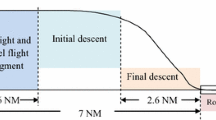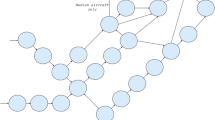Abstract
Predicting astronaut performance when choosing where to land on the Moon, or the landing point designation task, is difficult. Human judgment and decision making for this application is not well-characterized. To address this knowledge deficiency, an experiment was designed to replicate the landing point designation task in both ideal and poor landing conditions. Fifteen helicopter pilots were observed to use one of two strategy types, with both strategies resulting in equatable performance. Regardless of strategy use, terrain contrast conditions were observed to have a significant impact on the selection of safe landing sites. Other aspects of performance, such as task completion time, were unaffected by terrain contrast. Pilots were also observed to be influenced by multiple terrain factors. Researchers noted twenty different types of actions stemming from nine categories of scenario cues. When these cue–action relationships are used in conjunction with pilots’ evaluation criteria and a known strategy, models can be developed to predict decision making.







Similar content being viewed by others
Notes
Terrain contrast is perceived and discussed by pilots as lighting.
References
ACT-R (2011) Theory and architecture of cognition. Online. Accessed March 2011
Augustine NR (2009) Review of the U.S. Human Spaceflight Plans Committee. Technical report, U.S. Office of Science and Technology Policy
Bennett FV (1970) Apollo lunar descent and ascent trajectories. Technical report, National Aeronautics and Space Administration, Houston, Texas. Also presented at AIAA 8th aerospace sciences meeting, January 1970
Bisantz A, Roth E (2008) Reviews of human factors, chap 1. The Human Factors and Ergonomics Society, pp 1–43
Bisantz AM, Pritchett AR (2003) Measuring the fit between human judgments and automated alerting algorithms: a study of collision detection. Hum Factors 45:266–280
Brady T, Epp CD (2008) Challenge of a crewed polar lunar landing. Technical report, NASA exploration technology development program
Brady T, II S P, II T P C (2010) GN&C development for future lunar landing missions. In: AIAA guidance, navigation, and control conference, number AIAA 2010-8444, Toronto, Ontario, Canada. AIAA
Brady T, Paschall S (2010) The challenge of safe lunar landing. In: 2010 IEEE Aerospace Conference, Big Sky, MT. IEEE
Brunswik E (1952) The conceptual framework of psychology, vol 1. University of Chicago Press, Chicago
Busch C, Maret PSD, Flynn T, Kellum R, Le S, Meyers B, Saunders M, White R, Palmquist M (2005) Content analysis. Online. Retrieved on 09 April 2012
Byrne MD (2007) Human computer interaction handbook, chap 5. CRC Press, Boca Raton, pp 94–114
Card S, Moran T, Newell A (1983) The psychology of human-computer interaction. Lawrence Erlbaum Associates, Hillsdale
Chua ZK, Braun RD, Feigh KM (2009a) Analysis of human-system interaction for landing point redesignation. Masters AE 8900 project. Georgia Institute of Technology.
Chua ZK, Major LM, Feigh KM (2009b) Modeling cockpit interface usage during lunar landing redesignation. In: international symposium of aviation psychology
Cohanim B, Collins B (2009) Landing point designation algorithm for lunar landing. J Spacecr Rockets 46(4):858–864
Davis J, Striepe S, Maddock R, Hines G, II S P, Cohanim B, Fill T, Johnson M, Bishop R, DeMars K, Sostaric R, Johnson A (2008) Advances in POST2 end-to-end descent and landing simulation for the ALHAT project. In: AIAA/AAS astrodynamics specialist conference & exhibit, number AIAA 2008-6938
Drake AW, Keeney R (1986) Decision analysis. Massachusetts Institute of Technology, Center for Advanced Engineering Study
Einhorn HJ (1971) Use of nonlinear, noncompensatory models as a function of task and amount of information. Organ Behav Hum Perform 6:1–27
Endsley MR, Kaber DB (1999) Level of automation effects on performance, situation awareness and workload in a dynamic control task. Ergonomics 42(6):462–492
Feigh KM (2010) Incorporating multiple patterns of activity into the design of cognitive work support systems. Cognitive Technol Work 13:259–279
Fishburn PC (1970) Utility theory for decision making. Technical report, Research Analysis Corporation
Gore BF, Cacciabue P, Hjälmdahl, Luedtke, Riccioli, Costanza (eds) (2011) Man–machine Integration Design and Analysis System (MIDAS) v5: Augmentations, Motivations, and Directions for Aeronautics Applications. In: Human Modelling in Assisted Transportation. Milan, Springer, pp 43–54. doi:10.1007/978-88-470-1821-1_6
Gore BF (2010) Man-machine integration design and analysis system (MIDAS) v5: augmentations, motivations, and directions for aeronautics applications. Hum Model Assis Transp
Hammond KR, Hamm RM, Grassia J, Pearson T (1987) Direct comparison of the efficacy of intuitive and analytical cognition in expert judgment. IEEE Trans Syst Man Cybern 17(5):753–770
Hollnagel E (1993) Human reliability analysis context and control. Academic Press, London
Johnson KE, Kuchar JK, Oman CM (2002) Experimental study of automation to support time-critical replanning decisions. In: Proceedings of the human factors and ergonomics society 46th annual meeting, Baltimore, MD. HFES, p 3630
Johnson TR (1997) Control in ACT-R and soar. In: Shafto M, Langley P (eds) Proceedings of the 19th annual conference of the cognitive science society. Lawrence Erlbaum Associates, pp. 343–348
Klein G (1998) Sources of power: how people make decisions. MIT Press, MIT
Lehman JF, Laird J, Rosenbloom P (2006) A gentle introduction to soar, an architecture for human cognition. University of Michigan, 2260 Hayward, Ann Arbor, MI 48109-2121 http://ai.eecs.umich.edu/soar/sitemaker/docs/misc/GentleIntroduction-2006.pdf.
Lewis JL, Wheelwright CD (1965) Lunar landing and site selection study. Technical report NASA TN D-2999, National Aeronautics and Space Administration, Washington, DC
Major LM, Brady TM, II S C P (2008) Apollo looking forward: crew task challenges. In: IEEE aerospace conference 2008, number IEEEAC 1149, Big Sky, MT. IEEE
Major LM, Duda KR, Hirsh RL (2011) Crew office evaluation of a precision lunar landing system. In: IEEE aerospace conference.
Marr D (1982) Vision. W.H. Freeman, San Francisco, CA
McGovern A, Lopez N, Patterson W, Ernst C, Reid D (2010) DEMmaker users guide, 1.0 edn. Johns Hopkins University Applied Physics Laboratory, Baltimore, MD
Miles MB, Huberman AM (1999) Qualitative data analysis. Sage Publishers, Thousand Oaks
Mindell DA (2008) Digital apollo: human and machine in spaceflight. The MIT Press, Cambridge
NASA (2004) Take a spin around the inside of Altair. Online
Needham J (2008) Human-automation interaction for lunar landing aimpoint redesignation. Master’s thesis, Massachusetts Institute of Technology
Orasanu J, Connolly T (1993) Decision making in action: models and methods, chap 1, pp 1–20. Ablex
Orasanu J, Fischer U, McDonnell LJ, Davidson J, Haars KE (1998) How do flight crews detect and prevent errors? findings from a flight simulation study. In: Proceedings of the human factors and ergonomics society annual meeting
Parasuraman R, Riley V (1997) Humans and automation: use, misuse, disuse, abuse. Hum Factors 39:230–253
Parasuraman R, Sheridan TB, Wickens CD (2000) A model for types and levels of human interaction with automation. IEEE Transac Syst Man Cybern A Syst Hum 30(3):286–298
Rothrock L, Kirlik A (2003) Inferring rule-based strategies in dynamic judgment tasks: toward a noncompensatory formulation of the lens model. IEEE Transac Syst Man Cybern A Syst Hum 33(1):58–72
Simon HA (1956) Rational choice and the structure of the environment. Psychol Rev 63:129–138
Smith CA, Cummings L, Forest LM, Kessler LJ (2006) Utilizing ecological perception to support precision lunar landing. In: Proceedings of the human factors and ergonomics society annual meeting, vol 50, pp 91–95
Soelberg P (1967) Unprogrammed decision making. Indus Manag Rev 8:19–29
Sostaric RR (2007) Powered descent trajectory guidance and some considerations for human lunar landing. In AAS guidance and control conference, number AAS 07-051, Breckenridge, CO. AAS
Tversky A, Kahneman D (1974) Judgment under uncertainty: heuristics and biases. Science 185(4157):1124–1131
Warwick W, McIlwaine S, Hutton R, McDermott P (2001) Developing computational models of recognition-primed decision making. In 10th conference on computer generated forces and behavioural representation
Acknowledgments
The authors thank Jessica DeRenzy and Philip Dewire for their help running and analyzing the experiment, Alexandra E. Coso for her feedback and useful insights, and Robert L. Hirsh for his guidance. This work sponsored by the NASA Graduate Student Researchers Program (GSRP).
Author information
Authors and Affiliations
Corresponding author
Rights and permissions
About this article
Cite this article
Chua, Z.K., Feigh, K.M. Pilot decision making during landing point designation. Cogn Tech Work 15, 297–311 (2013). https://doi.org/10.1007/s10111-012-0233-8
Received:
Accepted:
Published:
Issue Date:
DOI: https://doi.org/10.1007/s10111-012-0233-8




